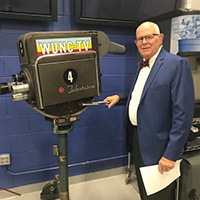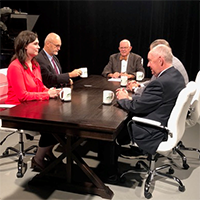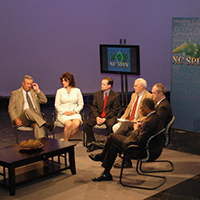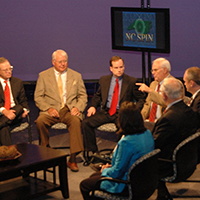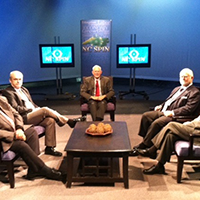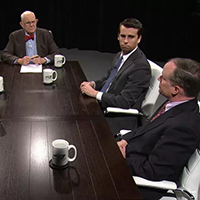Mrs. Rhinehart. Mr. Tharrington. Mrs. Riddle. Ms. Horton. Mr. Burton. Mrs. Marks.
Even as I approach my 30th high school reunion this year, I can quickly recite the names of teachers who believed in me, invested in me and challenged me (and vice versa I’m quite sure). I suspect most of us can easily recall those names and faces of our teachers, particularly those who had profound effects on our development in and outside of the classroom – what I call our “life-shaping teachers.”
With the N.C. General Assembly convening for a new session, education will once again be a top focus for lawmakers, and no issue looms larger than how our state will support and invest in our teachers, in particular how we bring life-shaping teachers into North Carolina’s classrooms and help them connect with our students, especially those who need them the most.
In 2014, North Carolinians focused significant attention on teacher pay. State leaders responded by enacting a substantial salary increase, weighted heavily toward teachers in the early years of their careers. These early years are when teachers grow most in their effectiveness but also tend to leave in larger numbers.
Prior to last year’s teacher pay raises, North Carolina ranked near the bottom, regionally and nationally, in many teacher pay categories, including average teacher salaries and beginning teacher salaries. From 1999 to 2013, North Carolina’s teachers as a whole endured a 14.7 drop in their annual salaries, by far the steepest decline in the country. No other state’s average salary dropped more than 10 percent in the same period, and no other state in the Southeast fell more than 6.5 percent.
The 2014 raises were a strong step in the right direction. However, attracting and retaining the best teachers in the nation requires a sustained, dynamic approach to teacher compensation.
One strategy that policymakers ought to pursue is developing highly paid opportunities for teachers to advance in their careers without leaving the classroom. State leaders could afford substantial leeway to districts to design innovative roles for teachers and to differentiate pay based on the skills and competencies demanded by these roles. At the same time, the state should provide sufficient financial support to enable low-wealth districts to take full advantage of this flexibility to attract and retain excellent teachers through redesigned roles.
The state must maintain the strong upward salary trend for North Carolina’s teachers. Our students’ long-range success depends on a sustained commitment to teacher pay that raises our state’s salaries to be competitive with other states in the Southeast and across the country. The state should also target pay incentives to areas shown by research to have greatest effect on student learning, including rewarding teachers for obtaining credentials such as master’s degrees in math, science and other specialty areas, and for those opting to teach and remain in high-need subjects or in schools and districts experiencing chronic shortages of highly effective teachers.
And lawmakers shouldn’t forget our veteran teachers. It was widely acknowledged after the last session that many veteran teachers received meager raises while pay for newer teachers improved dramatically. While years of experience alone should not dictate teacher pay priorities, given the past several years of salary stagnation, state leaders should consider boosting the pay of longer-serving teachers.
Beyond investing in our current teachers, North Carolina must recruit the best to teach our students. A growing number of quality teachers will be needed over the coming years due to a growing student population, increasing number of retiring educators and high teacher turnover.
One cause for alarm is the precipitous drop in students entering UNC system’s Colleges of Education, the single largest source of the state’s public school teachers. These schools account for more than a third of our teacher workforce. Enrollment in the UNC education programs was down 12 percent from fall 2013 to fall 2014 – over the last five years, down by over 27 percent. The actual numbers are truly shocking: We have 6,000 fewer students in the UNC teacher preparation programs today than we had in 2010.
Existing programs are not attracting enough high school graduates to pursue teaching, particularly in high-need fields. The N.C. Teaching Fellows program, administered by the Public School Forum, was eliminated in 2011 and is graduating its final class of 500 teachers this spring, leaving a gaping hole in our state’s teacher pipeline. The General Assembly should consider a new public-private partnership to fill this void, providing scholarships for undergraduate and graduate education for students who commit to teach in North Carolina, perhaps targeted to high-need subjects or hard-to-staff schools.
Many other education issues will make headlines in 2015, among them A-F School Performance Grades, school choice, expanded learning and digital learning. On Wednesday, the Public School Forum will release its “Top Ten Education Issues of 2015,” touching on these issues.
N.C. leaders need to recognize the singular impact of a great teacher and develop and implement policies that honor the realities and challenges of leading classrooms. The goal of education policy proposals in 2015 should be putting as many life-shaping teachers in charge of student learning as possible.
Keith Poston is president and executive director of the Public School Forum of North Carolina.
